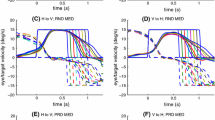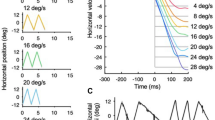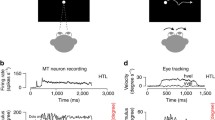Abstract
Humans can overcome the 150 ms time delay of the smooth pursuit eye movement system and track smoothly moving visual targets with zero-latency. Our target-selective adaptive control model can also overcome an inherent time delay and produce zero-latency tracking. No other model or man-made system can do this. Our model is physically realizable and physiologically realistic. The technique used in our model should be useful for analyzing other time-delay systems, such as man-machine systems and robots.
Similar content being viewed by others
References
Bahill, A.T.: Bioengineering: biomedical, medical and clinical engineering. Englewood Cliffs, NJ: Prentice-Hall Inc. 1981
Bahill, A.T., Brockenbrough, A.E., Troost, B.T.: Variability and development of a normative data base for saccadic eye movements. Invest. Ophthalmol. Vis. Sci.21, 116–125 (1981)
Bahill, A.T., Clark, M.R., Stark, L.: Dynamic overshoot in saccadic eye movements is caused by neurological control signal reversals. Exp. Neurol.48, 107–122 (1975)
Bahill, A.T., Latimer, J.R., Troost, B.T.: Linear homeomorphic model for human movement. IEEE Trans. Biomed. Engr. BME-27, 631–639 (1980)
Bahill, A.T., McDonald, J.D.: Smooth pursuit eye movements in response to predictable target motions. Vision Res. (1983) (in press)
Becker, W., Jurgens, R.: An analysis of the saccadic system by means of double step stimuli. Vision Res.19, 967–983 (1979)
Dallos, P.J., Jones, R.W.: Learning behavior of the eye fixation control system. IEEE Trans. Autom. Control. AC-8, 218–227 (1963)
Eckmiller, R.: A model of the neural network controlling foveal pursuit eye movements. In: Progress in Oculomotor Research, pp. 541–550. Fuchs, A.F., Becker, W., (eds.) New York: Elsevier/North-Holland 1981
Eckmiller, R., Mackeben, M.: Pre-motor single unit activity in the monkey brain stem correlated with eye velocity during pursuit. Brain Res.184, 210–214 (1980)
Greene, D.F., Ward, F.E.: Human eye tracking as a sequential input adaptive process. Biol. Cybern.33, 1–7 (1979)
Kleinman, D.L., Pattipati, K.R., Ephrath, A.R.: Quantifying an internal model of tartet motion in a manual tracking task. IEEE Syst. Man Cybern. SMC-10, 624–636 (1980)
Kowler, E., Steinman R.M.: The effect of expectations on slow oculomotor control. Vision Res.19, 619–646 (1979)
Lanman, J., Bizzi, E., Allum, J.: The coordination of eye and head movement during smooth pursuit. Brain Res.153 39–53 (1978)
Leigh, R.J., Newman, S.A., Zee, D.S., Miller, N.R.: Visual following during stimulation of an immobile eye (the open loop condition). Vision Res.22, 1193–1197 (1982)
Mack, A., Fendrich, R., Wong, E.: Is perceived motion a stimulus for smooth pursuit. Vision Res.22, 77–88 (1982)
McDonald, J.D., Bahill, A.T.: Zero-latency tracking of predictable targets by time-delay systems. Intl. J. Control (1983) (in press)
McRuer, D.T.: Human dynamics in man-machine systems. Automatica16, 237–253 (1980)
Michael, J.A., Melvile Jones, G.: Dependence of visual tracking capability upon stimulus predictability. Vision Res.6, 707–716 (1966)
Rashbass, C.: The relationship between saccadic and smooth tracking eye movements. J. Physiol.159, 326–338 (1961)
Rashbass, C.: Reflexions on the control of vergence. In: Models of oculomotor behavior and control, pp. 139–148. Zuber, B.L. (ed.). Boca Raton, FL: CRC Press 1981
Robinson, D.A.: Oculomotor control signals. In: Basic mechanisms of ocular motility and their clinical implications, pp. 337–374. Lenerstrand, G., Bach-y-Rita, P. (eds.). New York: Pergamon Press 1975
Schalen, L.: Quantification of tracking eye movements in normal subjects. Acta Otolaryngol.90, 404–413 (1980)
Stark, L., Vossius, G., Young, L.R.: Predictive control of eye tracking movements. IRE Trans. Human Factors Electron. HFE-3, 52–57 (1962)
Steinbach, M.: Pursuing the perceived rather than the retinal stimulus. Vision Res.16, 1371–1376 (1976)
Van Gisbergen, J.A.M., Robinson, D.A., Gielen, S.: A quantitative analysis of generation of saccadic eye movements by burst neurons. J. Neurophysiol.45, 417–422 (1981)
Westheimer, G.: Eye movement responses to a horizontally moving visual stimulus. AMA Arch Ophthalmol.52, 932–941 (1954)
Westheimer, G.: Mechanism of saccadic eye movements. AMA Arch. Ophthamol.52, 710–724 (1954)
Winterson, B.J., Steinman, R.M.: The effect of luminance on human smooth pursuit of perifoveal and foveal targets. Vision Res.18, 1165–1172 (1978)
Wyatt, H.J., Pola, J.: Slow eye movements to eccentric targets. Invest. Ophthalmol. Vis. Sci.21, 477–483 (1981)
Wyatt, H.J., Pola, J.: The role of perceived motion in smooth pursuit eye movements. Vision Res.19, 613–618 (1979)
Yasui, S., Young, L.: Perceived visual motion as effective stimulus to pursuit eye movement system. Science190, 906–908 (1975)
Young, L.: Pursuit eye tracking movements. In: The control of eye movements, pp. 429–443. Bach-y-Rita, P., Collins, C.C., Hyde, J. (eds.). New York: Academic Press 1971
Young, L.: Pursuit eye movements — what is being pursued. In: Control of gaze by brain stem neurons, pp 29–36. Baker, R., Berthoz, A. (eds.). Amsterdam: Elsevier/North-Holland Biomedical Press 1977
Young, L.R.: The sampled data model and foveal dead zone for saccades. In: Models of oculomotor behavior and control, pp. 43–74. Zuber, B.L. (ed.). Boca Raton, FL: CRC Press 1981
Young, L.R., Stark, L.: Variable feedback experiments testing a sampled data model for eye tracking movements. IEEE Trans. Human Factors Electron. HFE-4, 38–51 (1963)
Zuber, B.L., Semmlow, J.L., Stark, L.: Frequency characteristics of the saccadic eye movement. Biophys J.8, 1288–1298 (1968)
Author information
Authors and Affiliations
Rights and permissions
About this article
Cite this article
Bahill, A.T., McDonald, J.D. Model emulates human smooth pursuit system producing zero-latency target tracking. Biol. Cybern. 48, 213–222 (1983). https://doi.org/10.1007/BF00318089
Received:
Issue Date:
DOI: https://doi.org/10.1007/BF00318089




